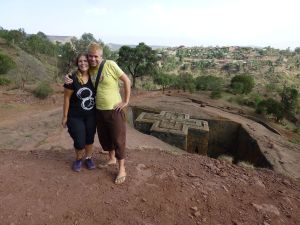We flew from Addis Ababa to Lalibela, a little town perched on the hills in the north of Ethiopia. We decided to do our “Northern Tour” independently rather than on a tour as we wanted to be able to do things in our own time. Our first stop was the town of Lalibela, known largely for its churches. It’s a UNESCO world heritage site. The 11 churches are carved out of single pieces of stone – the local story is that King Lalibela had humans working on them during the daytime and in the night time the angels continued the work. We arrived in the morning and after lunch headed down to check out the churches. However, we had to turn around and walk back up the hill to our hotel as we hadn’t brought enough money to buy our tickets. We learned on arrival that in January 2013 prices went up from 300 birr per person ($16 USD) to 936 birr per person ($50 USD). Considering that our hotel for the night cost 300 birr and meals start around 40 birr, we thought this was crazily overpriced but since had come all this way we decided to see the churches anyway. We started by going to the Northwestern group of churches and decided not to get a guide as the tickets had been so much more than expected. Apparently the raise in ticket price has only benefited the priests – locals don’t seem to like it as people don’t want to spend more money on guides, and there have been no improvements made at the churches in 7 years (no toilets, signs, information etc) so it is hard to see where the money is going!
The Northwestern group has six churches in it – we explored these by ourselves and used the Lonely Planet guidebook for more information. We managed to get a bit lost, but we also managed to see all the churches, find one that was off the map where the priest showed us a cross, and find a random tunnel and cave that was definitely not on the official tour!






Our last stop for the day was the most famous of the churches, Bet Giyorgis (St George), pictured above. This incredible church stands alone, a short walk from the Northwestern group. You approach from the top and then walk down a passageway to explore it.




On our second day in Lalibela, we had planned to take a mule ride up to Ashetan Maryam. However, when we wanted to go the mule owners were nowhere to be found, so we decided to hike up instead. We managed to get lost ,argue, take a very long way up, and after hiking for an hour and a half in the heat decide that the plateau was a good place to stop. The hike was very steep – we definitely would have been better taking mules! So, we didn’t actually see the monastery at Ashetan Maryam – but we got some exercise and a stunning view over Lalibela. (I also swore off all hiking for the foreseeable future…that lasted about four days until we were in Gonder!)



In the afternoon of the second day we visited the Southeastern group of churches. This group of 4 churches is really hard to find – we managed to get lost trying to find it – but worth the effort, as they are a lot of fun to explore – lots of clambering and exploring.




This was the third time I have been to Lalibela, and it (unlike Addis Ababa) seemed largely unchanged. We were glad to have two nights there – this gave us time to explore a bit, take time to have coffees, spend as much time as we wanted at the churches and to find Unique restaurant. The sign says it all.

This post brought such a big smile to my face, with happy memories of our visit there in 2006, and amusement at the challenges you faced in touring without guides, and trying to reach the monastery.
By the way, you don’t look grumpy in the photo… but I can imagine the conversation off-camera. I am sorry you did not succeed in seeing the monastery.
LikeLike